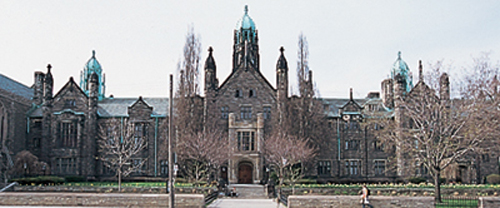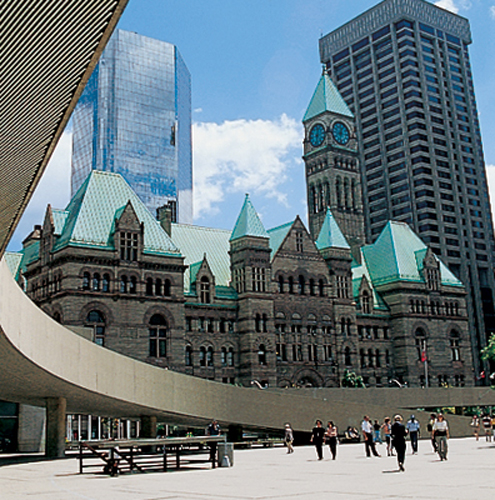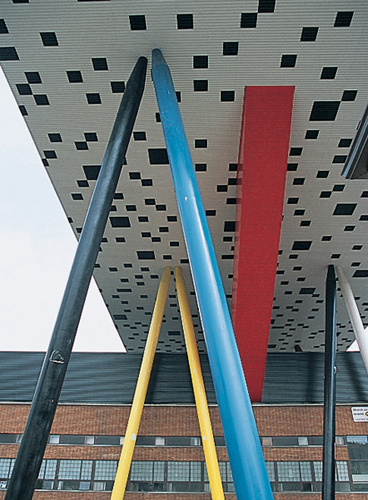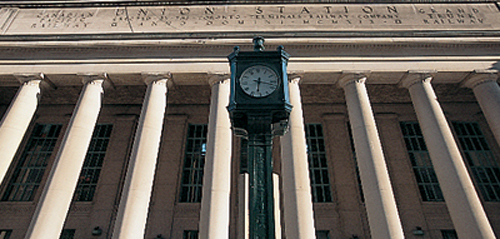BCE Place Spanish
architect Santiago Calatrava designed the striking atrium of this 1990
office complex. Its steel-and-glass canopy creates enchanting patterns
of light and shadow. Façades of 19th-century buildings have been
preserved in the Yonge Street frontage. Toronto-Dominion Centre Two
austere, perfectly proportioned towers and a single-story pavilion of
glass and black metal, all set on a broad plaza, are Toronto’s only
design by International Style architect Ludwig Mies van der Rohe
(1886–1969). Built between 1964 and 1971, the complex spurred the
skyscraper boom that gave birth to the city’s financial district. Four
more towers were later added .
CN Tower Defining the skyline, Toronto’s most recognizable architectural icon is also the world’s tallest freestanding structure .
University of Toronto Founded
in 1827 as King’s College, this institute has many refined, stately
buildings, such as the Romanesque Revival-style University College .

Trinity College, University of Toronto
City Hall Causing
a significant stir in 1960s Toronto, the design of New City Hall is
bold, daring, and unique. Finnish architect Viljo Revell’s two curving
towers seem to embrace the central domed structure between them. A
sweeping public plaza out front, Nathan Phillips Square, is the symbolic
heart of the city .

City Hall
Old City Hall Now
a courthouse, this Richardsonian Romanesque building, completed in
1899, was designed by the architect responsible for many of Toronto’s
grandest historic buildings, E. J. Lennox. For the best view of the
clock tower, look north up Bay Street .

Old City Hall
Sharpe Centre for Design Propped
up on 100-ft (30-m) stilts, British architect Will Alsop’s addition to
the Ontario College of Art and Design is playful and audacious. The
two-story “tabletop” building connects to the main building via a
sloping tunnel.

Sharpe Centre for Design
Royal Bank Plaza The
14,000 mirrored windows of the two towers (1977) are insulated with
24-karat gold – $70 worth on each window, for a total of some $1
million, money saved on heating. Ontario Legislative Building The
best view of this massive Richardsonian Romanesque building (1892), the
seat of provincial government, is from College Street, looking north
past the expanse of lawn. Built on the former site of a lunatic asylum
(political pundits take note), the richly carved exterior is matched by
the ornate interior . Union Station The Great Hall of this 1920s monumental stone railroad station has an 88-ft- (27-m-) high vaulted ceiling .

Union Station
Top 10 Public Art Sites
The Pasture Joe Fafard’s seven bronze, life-size cows in gentle repose. Three Way Piece No. 2 Aka The Archer, this Henry Moore bronze, controversial when installed in 1966, is now a local favorite. Wall and Chairs Curved walls intersected by a triangle of three chairs echo the severe beauty of city towers. Toronto Sculpture Garden Rotating exhibits of contemporary site-specific works. Elevated Wetlands Don River water is recycled as it filters through plants atop large white bearlike forms. Search Light, Star Light, Spot Light Three hollow metal columns are pierced by hundreds of stars; lit from within, they glow like searchlights. Untitled (Mountain) A gorgeously layered aluminum sculpture, cut with water jets, by Anish Kapoor. The Audience Boisterous “fans” spill out of the SkyDome in this frieze by Michael Snow. Woodpecker Column Woodpeckers strike at a 100-ft (30-m) column. City People Colorful aluminum figures spin softly in the breeze.
|